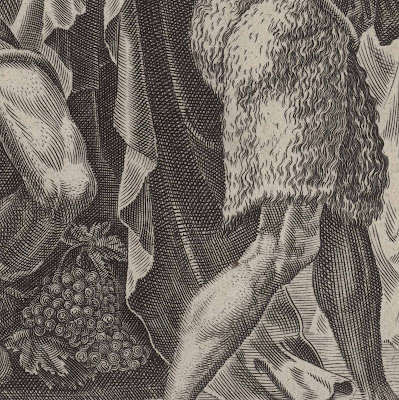Orazio Borgianni (aka
Orazio Borgiani) (c1578–1616)
“God appearing to Moses” (TIB title) (“Dieu
apparoȋt à Moīse au milieu du buisson ardent” [Bartsch title]), 1615 (inscribed
on plate), plate 30 from the series of 52 etchings after Raphael, “The Loggia
Paintings” (TIB title).
Etching on fine laid paper, trimmed with narrow margins around the platemark and backed with a support sheet.
Size: (sheet) 16.1 x 18.7 cm; (plate)
15.9 x 18.5 cm.
Numbered on plate at lower left: “30”.
Inscribed on plate within the image
borderline: (on stone at lower left corner) “1615 / [artist’s monogram]”
Lifetime impression of the only state.
(Note: attribution of this print to a lifetime impression is based on the crisp
quality of the lines showing minimal wear to the plate.)
TIB 38 (17).30(318) (Walter L Strauss
[ed.] 1979, “The Illustrated Bartsch”, vol. 38, New York, Abaris Books, p. 389);
Bartsch XVII.318.30.
The Rijksmuseum offers the following
description of this print:
(transl.) “God appears to Moses in the
burning bush. Moses is kneeling with his hands in front of his face.”
See also the description of this print
offered by the British Museum:
Condition: richly inked and near faultless
museum-quality impression in excellent condition for its age (i.e. there are no
tears, holes, folds, abrasions, stains, foxing or significant signs of use).
The sheet is backed with a support sheet of archival (millennium quality) washi
paper.
I am selling this superb lifetime
impression executed in the last year of the artist’s life and based on
the design of the legendary Raphael (1483–1520) who had passed away only 95
years before this print was created, for AU$257 (currently US$180.49/EUR158.67/GBP14211
at the time of this listing) including postage and handling to anywhere in the
world (but not, of course, any import duties/taxes imposed by some countries).
If you are interested in purchasing this
rare Renaissance period print, please contact me
(oz_jim@printsandprinciples.com) and I will send you a PayPal invoice to make
the payment easy.
This print has been sold



















































